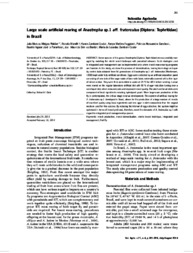Large scale artificial rearing of Anastrepha sp.1 aff. fraterculus (Diptera: Tephritidae) in Brazi.
Large scale artificial rearing of Anastrepha sp.1 aff. fraterculus (Diptera: Tephritidae) in Brazi.
Author(s): WALDER, J. M. M.; MORELLI, R.; COSTA, K. Z.; FAGGIONI, K. M.; SANCHES, P. A.; PARANHOS, B. A. J.; BENTO, J. M. S.; COSTA, M. de L. Z.
Summary: Some species of the genus Anastrepha (Diptera: Tephritidae) are successfully man - aged by matching the sterile insect technique with parasitoid releases. Such strategies used in integrated pest management can be implemented only where insect mass-rearing programs are feasible. In this study, we show the process of domestication, rearing technology and qual - ity control data obtained from 54 generations of Anastrepha sp.1 aff. fraterculus (Wiedemann,1830) kept under fully artificial conditions. Eggs were collected by an artificial oviposition panel consisting of one side of the cage made of blue voile fabric externally covered with a thin layer of silicon rubber. They were then air-bubbled in water at 25 ºC for 48 h before seeding. Larvae were reared on the regular laboratory artificial diet with 66 % of agar reduction turning over a semi-liquid diet, which reduced costs and improved insect quality. The adult and larval diets were composed of local ingredients including hydrolyzed yeast. When large-scale production of this fly is contemplated, the critical stage is larval development. This system of artificial rearing for A. fraterculus sp.1 developed in Brazil, allows for the production of a large number of insects of excellent quality using local ingredients and less agar in diet composition than the original medium used for this species. By reducing the interval of egg collection, the system might be optimized in terms of insect yield and, therefore, meet the demands of A. fraterculus sp.1 with regard to integrated pest management purposes.
Publication year: 2014
Types of publication: Journal article
Unit: Embrapa Semi-arid Region
Observation
Some of Embrapa's publications are published as ePub files. To read them, use or download one of the following free software options to your computer or mobile device. Android: Google Play Books; IOS: iBooks; Windows and Linux: Calibre.
Access other publications
Access the Agricultural Research Database (BDPA) to consult Embrapa's full library collection and records.
Visit Embrapa Bookstore to purchase books and other publications sold by Embrapa.

